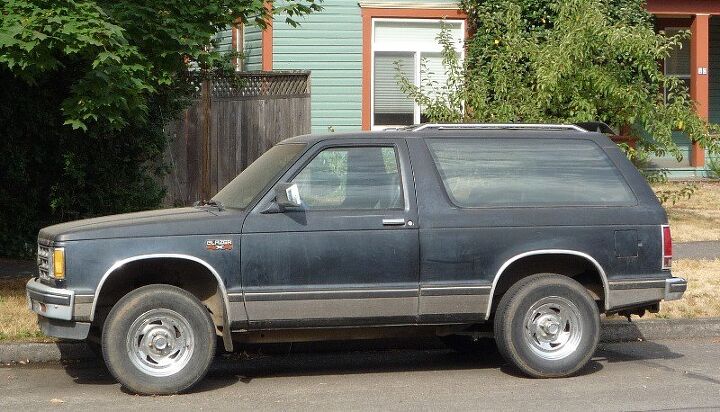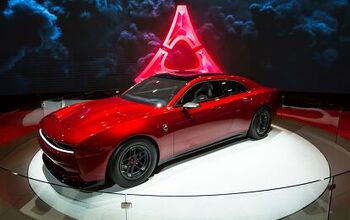Curbside Classic: GM's Deadly Sin #5 – 1983 Chevy S-10 Blazer

This Curbside Classic took the same trajectory as the Blazer. It started as a legitimate nod of acknowledgment to the S-10 Blazer as the trailblazer of the compact SUV market. But as I got further along, I realized just how badly GM bungled the huge opportunity for the baby Blazer in a segment that became a monster money machine for Jeep and Ford. With the mistakes being all so prototypical GM, I just had to re-write it as a Deadly Sin, even though it would have been easier to just leave it as it was. Which is exactly what GM’s Deadly Sin was: leave it as it was, forever. Well I’m not ready just yet to have someone document my Deadly Journalistic Sins, so here goes: Blazer, take Two.
Before any mud-slinging begins, lets define the new category that this Blazer blazed. Sure the Jeep CJ was always compact, as were the first generations of Scout and Bronco. But those were uncompromising 4×4 offroaders, first and foremost. The S-10 Blazer was the first of the compact and reasonably comfortable four-wheelers that were equally, if not more at home on the road than off it.
The only other competitors to the compact Blazer’s eponymous title are the Isuzu Trooper II and the Mitsubishi Montero (Pajero). They both appeared on our shores about the same time the Blazer started rolling off GM’s assembly lines. The Montero came only in the short wheelbase version then, and it was rather trucky; more like a Japanese update on the Jeep or Scout rather than defining a new category. And the Trooper II was, well, a longer wheelbase version of the Montero formula. I’ve got a soft spot for them both, and we’ll cover them on a future CC. But lacking a V6, a softish ride, the “cute” styling element, and probably most importantly, the vast Chevrolet dealer network, they both were relegated to outsider status, at least initially.
The baby Blazer appeared during my LA years. And what a godsend it must have been to the Chevy dealers in the decade Californians started shunning domestic passenger cars like coughing airline passengers. Well, make that mainly GM and Chrysler dealers, as Ford was still getting some sunshine state love for its Taurus, Mustang and T-Bird. Anyway, the Blazer was a hot item in its first couple of years, especially with the ski set. My Peugeot 404 wagon was looking a wee bit archaic amongst the shiny new white and red Blazers driven by blond ski bunnies at the Mammoth Mt. Main Lodge parking lot.
Like the ski bunnies, the Blazer had its superficial attractions. But dig a little deeper, and things weren’t at all so pretty. The GMT 330 platform that underpinned the Blazer and its S-10 pickup sibling was an uninspired piece of work, unlike the Jeep Cherokee (XJ) that followed the Blazer by a year. The Chevy’s dull handling, crude ride, and mediocre build quality was quickly outclassed by the Cherokee.
The Blazer’s arrival in ’83 came on the heels of the very painful ’81 energy crisis. That was obviously the motivation in developing a little brother to the massive K-5 Blazer. But in that fleeting early-eighties zeal for fuel efficiencies, some dubious engines showed up under the S-10 Blazer’s hood. The standard mill was the 2.0 OHV four that also powered so many J-cars (Cavaliers, etc.). Managing a mere 83 hp, it might have been a passable choice for a stick-shift 2wd S-10 pickup, but the BOF Blazer was not the lightweight the unibody Cherokee was. Actually, in CA, an Isuzu-sourced 1.9 four (from the Trooper) was used for smog certification reasons. And if you really wanted to be thrifty, you could order the 2.2 liter diesel, also from Isuzu, which made all of 58 horsepower! Good times.
I remember hearing a couple of diesel-powered S-10 pickups, but not a Blazer. Would a 58 hp diesel Blazer be collectible? In reality, most of them came with the optional 2.8 V6, the longitudinal version of GM’s evergreen 60 degree V6. It sucked an awful lot of fuel to generate a measly 110 hp, but gas prices were dropping like a stone during the eighties, so who cared. Well, I did.
I finally succumbed to the SUV and monthly payment lure, and the dear old 404 wagon that cost me $100 gave way to a $16k ’85 Cherokee with that same Chevy 2.8. It was anything but brisk, and slurped gas at almost twice the rate of the Peugeot. But now we were officially Yuppies! Well, you had to be one to afford these trucklets, because they were anything but cheap. Decently optioned, with the basic amenities that are all standard today, transaction prices were stiff, like our Cherokee’s: adjusted for inflation, about $35k. And interest rates on loans were stratospheric. No wonder longer term car loans were invented in that era.
Mileage wise, it was a minor miracle to break out of the mid teens with the 2.8. Reliability was another highly marginal affair. Seems like a huge number of them had main rear seals that self-destructed in short order. We managed to dodge that bullet, but not with the world’s most complicated and expensive carburetor. Too cheap to install fuel injection, Rochester’s answer to CA emissions was a Rube Goldbergian affair, with no adjustments allowed without committing a federal offense. The inevitable replacement was over $500 bucks ($1000 adjusted), just for the part. I used to buy nice used cars for less than that. Eighties-style new car ownership was a painful adjustment for me.
The Blazer got some bigger engines after a few years, although both the Iron Duke 2.5 four and the 4.3 V6 were both notoriously unrefined in their manners. But the Blazer’s deadliest deficiency was the lack of two rear doors. Once the four-door Cherokee appeared, the Trooper and Montero quickly sprouted extra doors. Compact SUVs were becoming the station wagons of the era; who wanted to go back to the contortions of the long-gone two door wagons, especially with baby seats and seat belts?
But it took GM almost eight years to take a Sawzall in hand and carve out some damn rear doors. By then, the Cherokee had long stolen the show, at least until the new Ford Explorer appeared in 1991. And the Blazer’s design didn’t age nicely at all like the Cherokee, yet it wasn’t until 1995, after twelve years, that GM found fit to give it some new skin. By that time, it had long been relegated to a distant third.
GM really fumbled the ball with the Blazer. For over twenty years, no serious effort was ever undertaken to improve a vehicle that was the crudest in its class to start with. In its latter years, it was a pathetic joke compared to the continually refined Explorer.
The reskinned Blazer stumbled along on the same old tired platform, until it expired in 2006. But if you’re in Brazil, you can still relive the GM of the early eighties and buy a new old Blazer, even with a four cylinder engine (the only choice, actually). The first shall be last, in more ways than one.

More by Paul Niedermeyer
Latest Car Reviews
Read moreLatest Product Reviews
Read moreRecent Comments
- Rochester I'd rather have a slow-as-mud Plymouth Prowler than this thing. At least the Prowler looked cool.
- Kcflyer Don't understand the appeal of this engine combo at all.
- Dave M. This and the HHR were GM's "retro" failures. Not sure what they were smoking....
- Kcflyer Sorry to see it go. The interior design and color options in particular are rare in the industry
- Wolfwagen Here is my stable. not great not bad I try to do as much as possible. I work for an Aftermarket automotive parts company so I can get most parts at a discount.i try to do as much of my own work as possible. My wife hates that I spend time and money fixing the vehicles but she doesn't want car payments either so...2019 VW Atlas 50K (wife's) Only issues so far were Brakes and normal maintenance.A Bad Cat Converter which was covered and a replacement of the rear bank head gasket which was a manufacturing defect due to improper torquing at the factory. All under warranty2003 Saab 9-5 Arc Wagon (my DD) 116 K picked up used last year. Replaced Struts, brakes, hatch struts, motor mounts, D/S swaybar link, Timing belt, water pump and thermostat Power steering pump Fuel pump, Both Front window regular rollers, Heater core and cabin air filter. Oil and transmission changes. Love the car but Saab/GM packaging is a nightmare.2005 Cadillac Deville (former DD now Son # 1 DD) picked up used 5 years ago with only 47K now 83K Plugs, coils, P/s pump, Water pump, hoses, P/S lines (mechanic job) evap valve, brakes, Front brake calipers and rear brake calipers. Currently has oil pan gasket leak - looking to have a mechanic do that2009 Mini Cooper (Daughters dd)picked up 2 years ago 67K Brakes and thermostat house to clear check engine light2001 Mazda Tribue (Son#2 dd) 106K picked last summer after he severely damaged a 2004 Hyundai accent. Oil changes





































Comments
Join the conversation
I was just reading the latin america (?) chevy site... When you're advertising stuff like clear lenses (with amber flashers) as one of the main features, you know you're vehicle is sorely lacking!
Florida is the Sunshine state. California is the Golden state